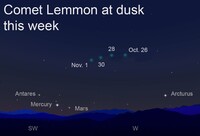Week of October 26 - November 1, 2025
It's been a few years since we've seen a decently bright comet grace the nighttime sky, but one is now passing through our celestial neighborhood. It certainly won't compare to the rare cosmic spectacles like Hale-Bopp or Hyakutake of the late 1990s, but it could become bright enough to see with the unaided eye.
Or not.
This comet was found on Jan. 3 by the Mount Lemmon Survey in Tucson, Arizona, although there are photos that show it as early as last November. It's designated as Comet Lemmon (C/2025 A6).
As confusing as it might seem, the International Astronomical Union's naming system for comets is rather straightforward. The comet discoverer's name comes first (in this case Lemmon). This is followed by "C/" to indicate that it's a nonperiodic comet and that this may be its first journey through the inner solar system. "2025" indicates the discovery year, and "A6" shows that it's the sixth comet found during the first half of January.
Of course, most of us just call it Comet Lemmon.
Like other comets, Lemmon is one of countless icy remnants of the primordial solar system that tumble silently in a region known as the Oort Cloud, billions of miles from the sun. Occasionally, one of these cosmic nomads drifts inward toward the sun's heat, and its ices disintegrate into a cloud of gas and dust around its nucleus (the "coma"). Sunlight and the solar wind act as a fan and blow this material outward to create one or two tails that always point away from our star.
On rare occasions, a comet becomes noteworthy enough to make the news, and we hope that's what happens with Comet Lemmon. The last time it passed our way was during the late seventh century, but on Oct. 21 of this year, it again swung only 56 million miles past our planet.
Now on its inward track toward the sun, it might make a nice object to view low in the western sky after sunset during this last week of October. But just how bright Comet Lemmon becomes is anyone's guess. Will it be bright enough to see with the unaided eye, or will we need binoculars or a small telescope to find it? No one can say for sure.
Predictions about the appearance of comets can be somewhat untrustworthy simply because they seem to have minds of their own. As noted comet-hunter David Levy so eloquently explains: "Comets are like cats. They both have tails, and they both do what they want."
Their unpredictable nature has led people over the ages - and even some today — to interpret them as cosmic harbingers of doom. Hard to dispute, since every time a comet appears, something bad is happening in the world. Of course, something bad is always happening even when a comet isn't visible, so make of this superstition what you will.
Check out the accompanying illustration for Comet Lemmon's changing position this week, and be sure to grab binoculars to scan the western horizon during dusk to seek out and enjoy this amazing interplanetary iceball.
If you miss it, don't worry. It'll return around the year 3175!

Visit Dennis Mammana at dennismammana.com. To read features by other Creators Syndicate writers and cartoonists, visit the Creators Syndicate website at www.creators.com.
Comet Lemmon, a comet discovered in January, may be visible with the unaided eye after sunset this week.






View Comments